Design, Fabrication, Structure Optimization and Pressure Sensing Demonstration of COC Piezoelectret Sensor and Sensor Array
Abstract
1. Introduction
2. Materials and Experimental Details
2.1. Materials and Fabrication Equipment
2.2. Fabrication of COC Piezoelectret
2.3. Characterization of COC Piezoelectret
2.3.1. Quasi-Static Piezoelectric Coefficient
2.3.2. Electric Hysteresis Loop
2.4. Pressure Sensing System Fabrication and Development
3. Result and Discussion
3.1. Piezoelectric Activity of COC Piezoelectret: Feasibility
3.2. Statistical Modeling and Experimental Validation of Optimized Structure for Maximized Piezoelectric Activity
3.3. Electrical and Piezoelectric Properties of COC Piezoelectrets with the Optimized Structure
3.3.1. Hysteresis Loop
3.3.2. Physics Based Model on Piezoelectric Coefficient
3.4. Pressure Sensing Application of the Prepared Material
4. Conclusions
Author Contributions
Funding
Data Availability Statement
Conflicts of Interest
References
- Savolainen, A.; Kirjavainen, K. Electrothermomechanical Film. Part I. Design and Characteristics. J. Macromol. Sci. Part A Chem. 1989, 26, 583–591. [Google Scholar] [CrossRef]
- Bauer, S.; Gerhard-Multhaupt, R.; Sessler, G.M. Ferroelectrets: Soft Electroactive Foams for Transducers. Phys. Today 2004, 57, 37–43. [Google Scholar] [CrossRef]
- Wegener, M.; Bauer, S. Microstorms in Cellular Polymers: A Route to Soft Piezoelectric Transducer Materials with Engineered Macroscopic Dipoles. ChemPhysChem 2005, 6, 1014–1025. [Google Scholar] [CrossRef] [PubMed]
- Samadi, A.; Hasanzadeh, R.; Azdast, T.; Abdollahi, H.; Zarintaj, P.; Saeb, M.R. Piezoelectric Performance of Microcellular Polypropylene Foams Fabricated Using Foam Injection Molding as a Potential Scaffold for Bone Tissue Engineering. J. Macromol. Sci. Part B 2020, 59, 376–389. [Google Scholar] [CrossRef]
- Zhang, X.; Huang, J.; Chen, J.; Wan, Z.; Wang, S.; Xia, Z. Piezoelectric properties of irradiation-crosslinked polypropylene ferroelectrets. Appl. Phys. Lett. 2007, 91, 182901. [Google Scholar] [CrossRef]
- Wang, H.; Li, Y.; Wang, X.; Liu, Z.; Ahmed, M.F.; Zeng, C. Preparation and Characterization of PiezoelectricI Foams Based on Cyclic Olefin Copolymer. Eng. Sci. 2021, 16, 203–210. [Google Scholar] [CrossRef]
- Li, Y.; Zeng, C. Low-Temperature CO2-Assisted Assembly of Cyclic Olefin Copolymer Ferroelectrets of High Piezoelectricity and Thermal Stability. Macromol. Chem. Phys. 2013, 214, 2733–2738. [Google Scholar] [CrossRef]
- Altafim, R.P.; Rychkov, D.; Wirges, W.; Gerhard, R.; Basso, H.; Altafim, R.C.; Melzer, M. Laminated tubular-channel ferroelectret systems from low-density polyethylene films and from fluoroethylene-propylene copolymer films-A comparison. IEEE Trans. Dielectr. Electr. Insul. 2012, 19, 1116–1123. [Google Scholar] [CrossRef]
- Voronina, O.; Wegener, M.; Wirges, W.; Gerhard, R.; Zirkel, L.; Münstedt, H. Physical foaming of fluorinated ethylene-propylene (FEP) copolymers in supercritical carbon dioxide: Single-film fluoropolymer piezoelectrets. Appl. Phys. A 2007, 90, 615–618. [Google Scholar] [CrossRef]
- Liu, Z.; Zeng, M.; Wang, H.; Wang, X.; Li, Y.; Zeng, C. Toward Flexible Piezoelectrets with High Environmental Stability: A Hybrid Approach. ES Mater. Manuf. 2022, 17, 73–82. [Google Scholar] [CrossRef]
- Zhang, X.; Zhang, X.; You, Q.; Sessler, G.M. Low-Cost, Large-Area, Stretchable Piezoelectric Films Based on Irradiation-Crosslinked Poly(propylene). Macromol. Mater. Eng. 2013, 299, 290–295. [Google Scholar] [CrossRef]
- Zhang, X.; Sessler, G.M.; Wang, Y. Fluoroethylenepropylene ferroelectret films with cross-tunnel structure for piezoelectric transducers and micro energy harvesters. J. Appl. Phys. 2014, 116, 074109. [Google Scholar] [CrossRef]
- Zhang, X.; Zhang, X.; Sessler, G.M.; Gong, X. Piezoelectric Performance of Polytetrafluoroethylene Ferroelectrets. In Proceedings of the 2013 Annual Report Conference on Electrical Insulation and Dielectric Phenomena, Shenzhen, China, 20–23 October 2013. [Google Scholar]
- Wirges, W.; Wegener, M.; Voronina, O.; Zirkel, L.; Gerhard-Multhaupt, R. Optimized Preparation of Elastically Soft, Highly Piezoelectric, Cellular Ferroelectrets from Nonvoided Poly(ethylene Terephthalate) Films. Adv. Funct. Mater. 2007, 17, 324–329. [Google Scholar] [CrossRef]
- NunesPelle, P.S.; Ohlsson, P.D.; Ordeig, O.; Kutter, J. Cyclic olefin polymers: Emerging materials for lab-on-a-chip applications. Microfluid. Nanofluid. 2010, 9, 145–161. [Google Scholar] [CrossRef]
- Saarimaki, E.; Paajanen, M.; Savijarvi, A.; Minkkinen, H.; Wegener, M.; Voronina, O.; Schulze, R.; Wirges, W.; Gerhard-Multhaupt, R. Novel heat durable electromechanical film: Processing for electromechanical and electret applications. IEEE Trans. Dielectr. Electr. Insul. 2006, 13, 963–972. [Google Scholar] [CrossRef]
- Montanari, G.C.; Fabiani, D.; Ciani, F.; Motori, A.; Paajanen, M.; Gerhard, R.; Wegener, M. Charging properties and time-temperature stability of innovative polymeric cellular ferroelectrets. IEEE Trans. Dielectr. Electr. Insul. 2007, 14, 238–248. [Google Scholar] [CrossRef]
- Savijarvi, A.M.; Paajanen, M.; Saarimaki, E.; Minkkinen, H. Novel Heat Durable Electromechanical Films: Cellular Film Making from Cyclic Olefin Polymers. In Proceedings of the 2005 12th International Symposium on Electrets, Salvator, Brazil, 11–14 September 2005. [Google Scholar]
- Wegener, M.; Paajanen, M.; Voronina, O.; Schulze, R.; Wirges, W.; Gerhard-Multhaupt, R. Voided Cyclo-Olefin Polymer Films: Ferroelectrets with High Thermal Stability. In Proceedings of the 2005 12th International Symposium on Electrets, Salvator, Brazil, 11–14 September 2005. [Google Scholar]
- Hillenbrand, J.; Sessler, G. Piezoelectricity in cellular electret films. IEEE Trans. Dielectr. Electr. Insul. 2000, 7, 537–542. [Google Scholar] [CrossRef]
- Sessler, G.M.; Hillenbrand, J. Electromechanical response of cellular electret films. Appl. Phys. Lett. 1999, 75, 3405–3407. [Google Scholar] [CrossRef]
- Lindner, M.; Bauer-Gogonea, S.; Bauer, S.; Paajanen, M.; Raukola, J. Dielectric barrier microdischarges: Mechanism for the charging of cellular piezoelectric polymers. J. Appl. Phys. 2002, 91, 5283–5287. [Google Scholar] [CrossRef]
- Tuncer, E.; Wegener, M. Elastic properties of highly anisotropic thin poly(propylene) foams. Mater. Lett. 2004, 58, 2815–2818. [Google Scholar] [CrossRef][Green Version]
- Qiu, X. Patterned piezo-, pyro-, and ferroelectricity of poled polymer electrets. J. Appl. Phys. 2010, 108, 011101. [Google Scholar] [CrossRef]
- Tuncer, E. Numerical calculations of effective elastic properties of two cellular structures. J. Phys. D Appl. Phys. 2005, 38, 497–503. [Google Scholar] [CrossRef][Green Version]
- Joseph, V.R.; Yan, H. Engineering-Driven Statistical Adjustment and Calibration. Technometrics 2015, 57, 257–267. [Google Scholar] [CrossRef]
- Joseph, V.R.; Melkote, S.N. Statistical Adjustments to Engineering Models. J. Qual. Technol. 2009, 41, 362–375. [Google Scholar] [CrossRef]
- Montgomery, D.C. Design and Analysis of Experiments; John Wiley & Sons: Hoboken, NJ, USA, 2008. [Google Scholar]
- Arockiarajan, A.; Delibas, B.; Menzel, A.; Seemann, W. Studies on nonlinear electromechanical behavior of piezoelectric materials using finite element modeling. Continuity 2005, 500, 3. [Google Scholar] [CrossRef]
- Yeh, T.-J.; Lu, S.-W.; Wu, T.-Y. Modeling and Identification of Hysteresis in Piezoelectric Actuators. J. Dyn. Syst. Meas. Control 2005, 128, 189–196. [Google Scholar] [CrossRef]
- Ding, C.; Cao, J.; Chen, Y. Fractional-order model and experimental verification for broadband hysteresis in piezoelectric actuators. Nonlinear Dyn. 2019, 98, 3143–3153. [Google Scholar] [CrossRef]



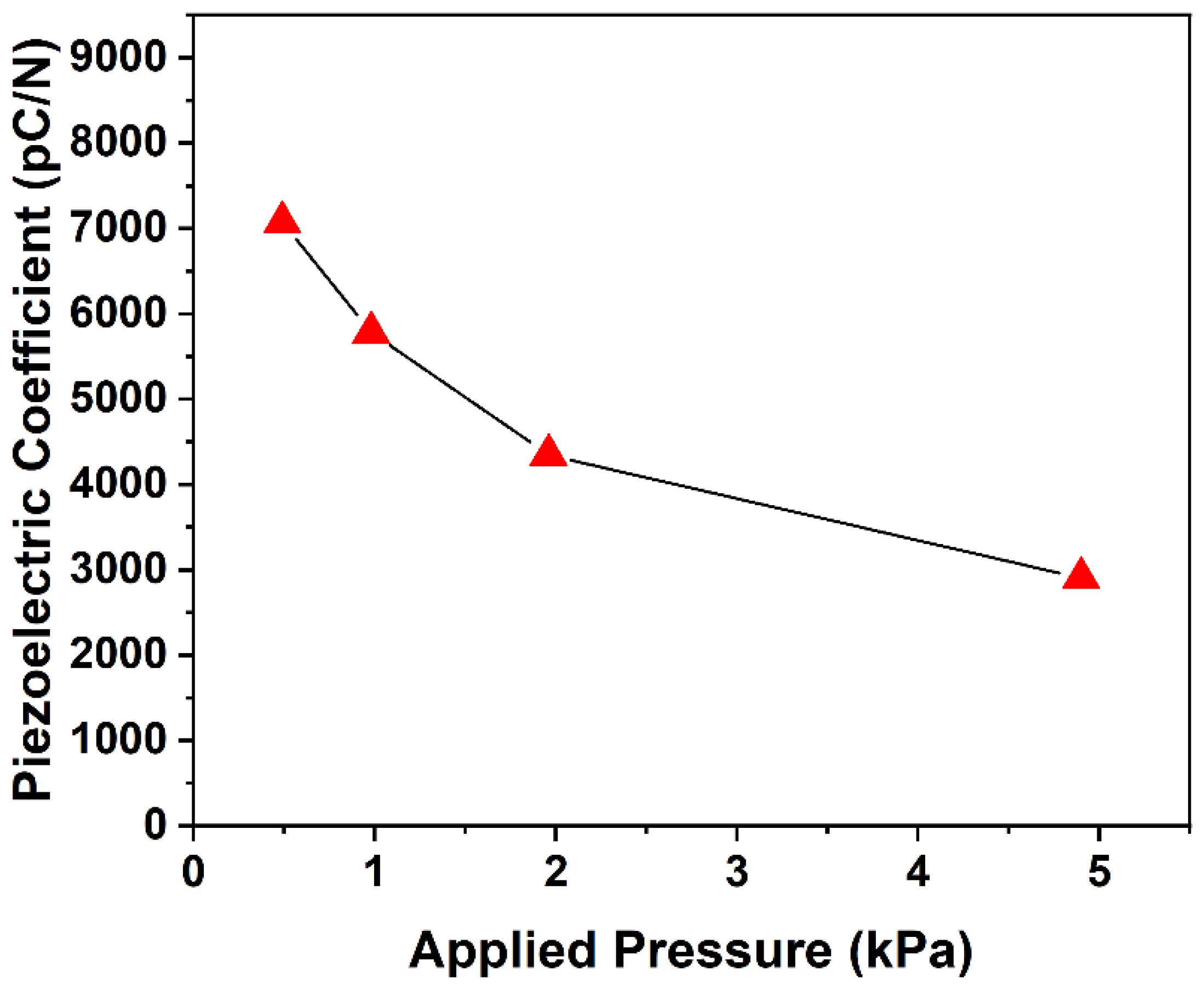
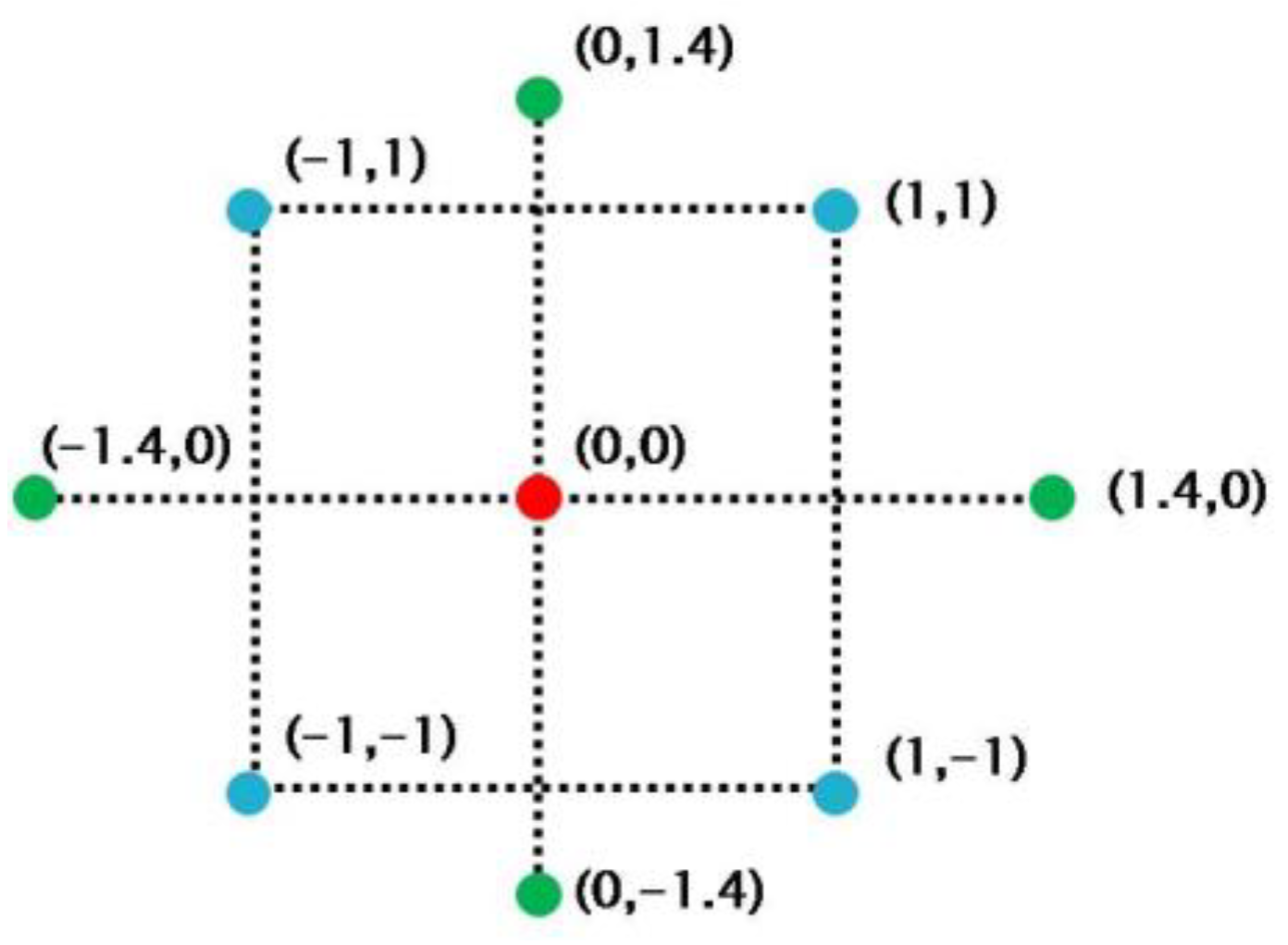
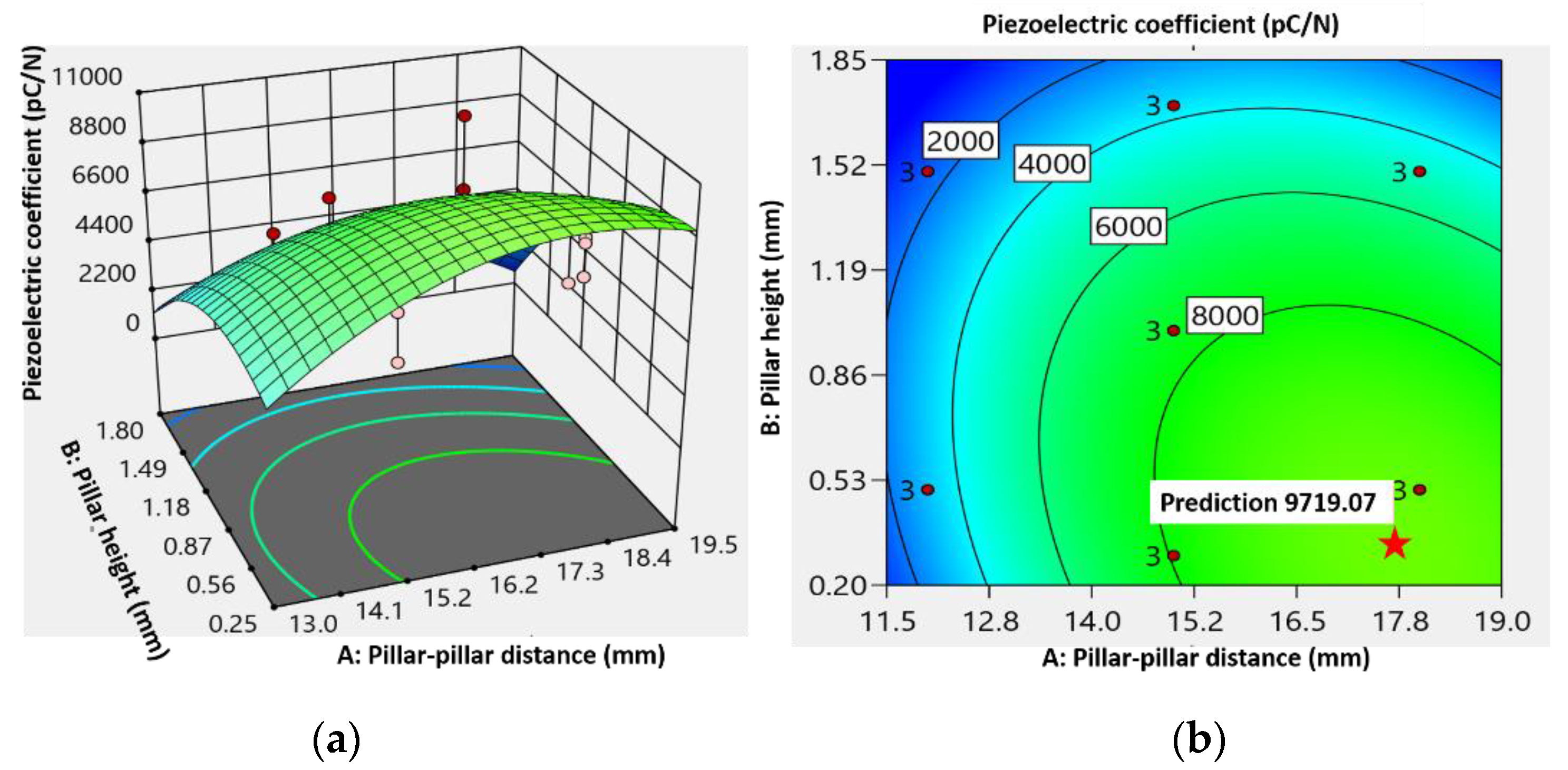

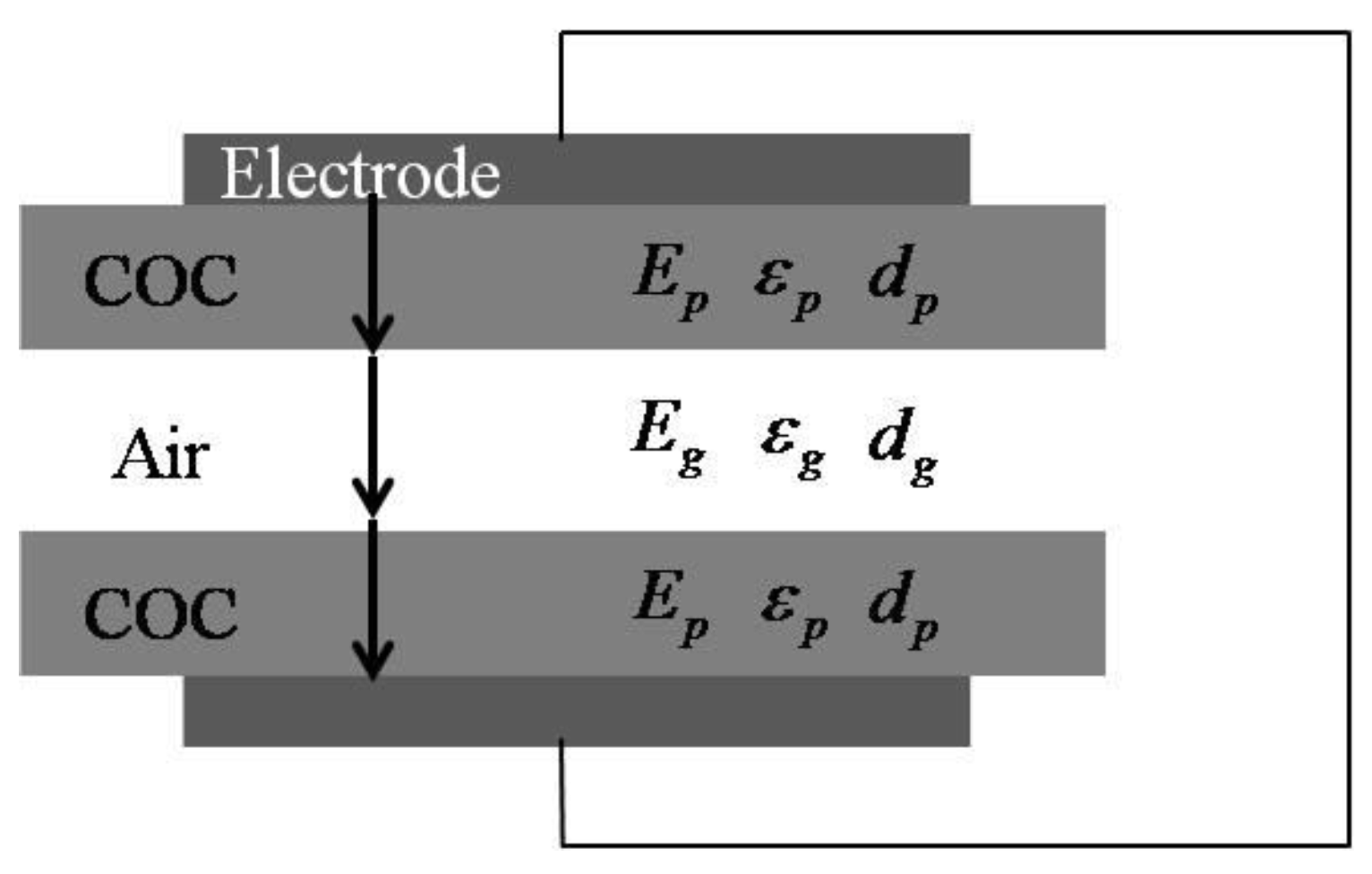
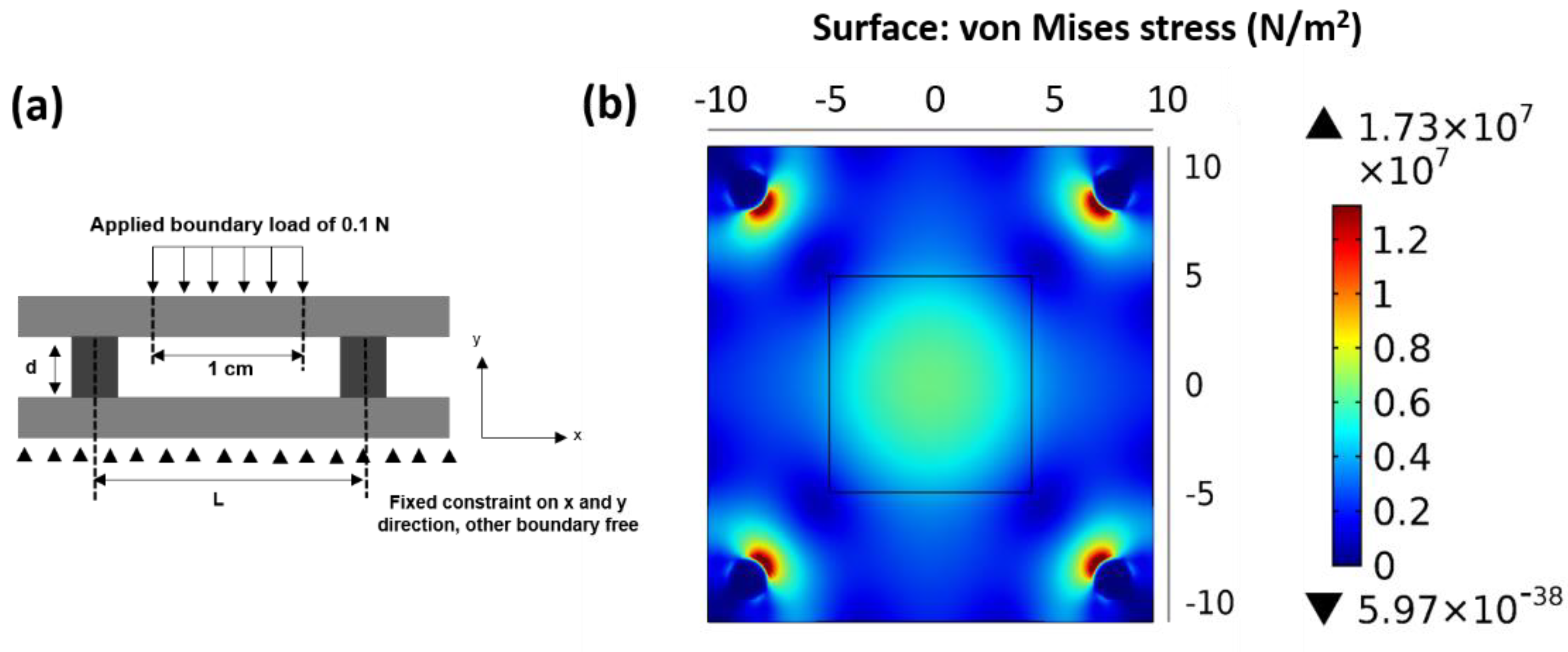
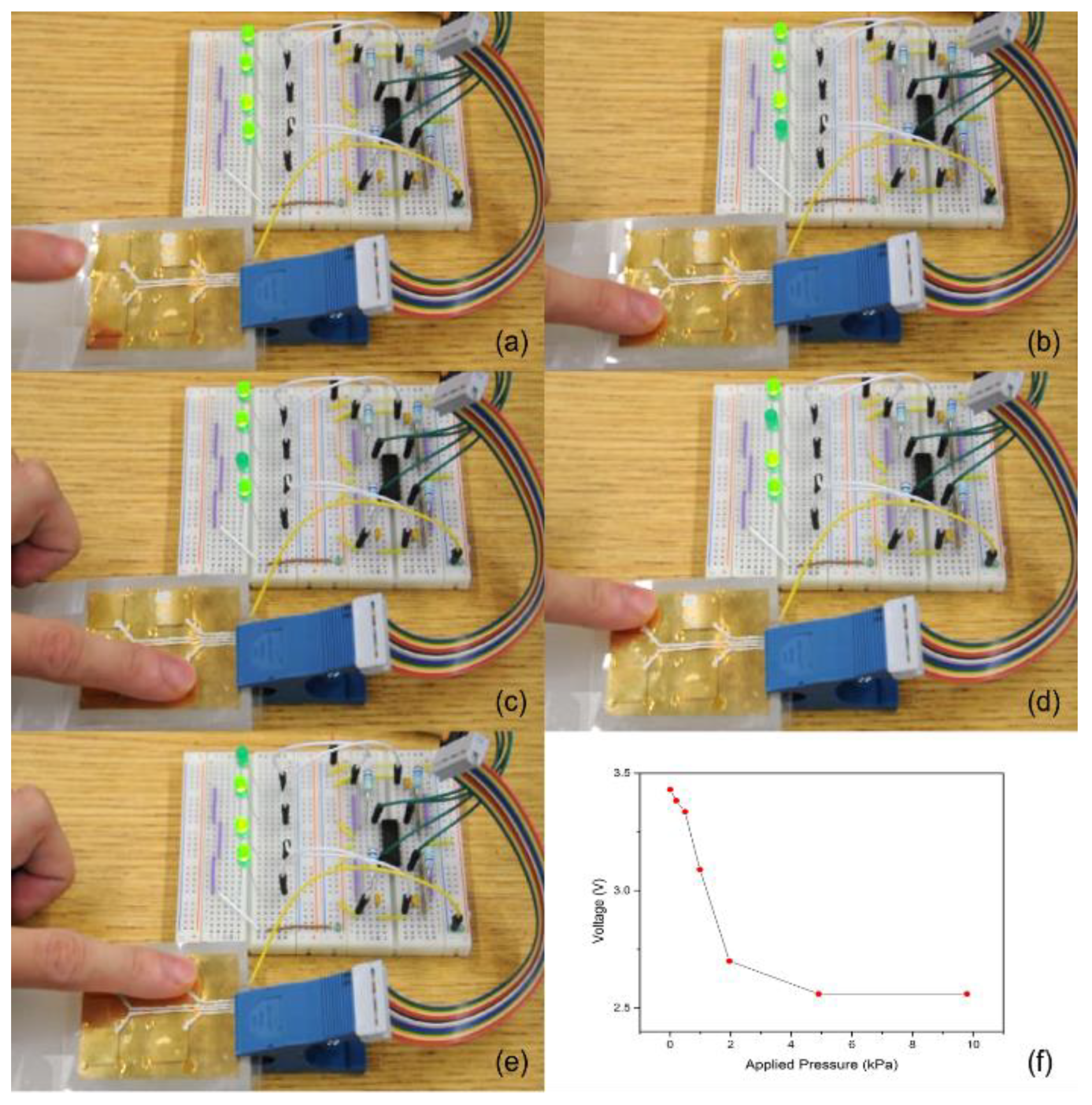
| Experimental Setup | Pillar Height, d (mm) | Pillar Distance, L (mm) | Pillar Height (Coded Variables) | Pillar Distance (Coded Variables) |
|---|---|---|---|---|
| 1 | 0.3 | 15 | −1.414 | 0 |
| 2 | 0.5 | 12 | −1 | −1 |
| 3 | 0.5 | 18 | 1 | 1 |
| 4 | 1 | 11 | 0 | −1.414 |
| 5 | 1 | 15 | 0 | 0 |
| 6 | 1 | 19 | 0 | 1.414 |
| 7 | 1.5 | 12 | 1 | −1 |
| 8 | 1.5 | 18 | 1 | 1 |
| 9 | 1.8 | 15 | 1.414 | 0 |
Publisher’s Note: MDPI stays neutral with regard to jurisdictional claims in published maps and institutional affiliations. |
© 2022 by the authors. Licensee MDPI, Basel, Switzerland. This article is an open access article distributed under the terms and conditions of the Creative Commons Attribution (CC BY) license (https://creativecommons.org/licenses/by/4.0/).
Share and Cite
Wang, H.; Wang, X.; Wadsworth, M.; Ahmed, M.F.; Liu, Z.; Zeng, C. Design, Fabrication, Structure Optimization and Pressure Sensing Demonstration of COC Piezoelectret Sensor and Sensor Array. Micromachines 2022, 13, 1177. https://doi.org/10.3390/mi13081177
Wang H, Wang X, Wadsworth M, Ahmed MF, Liu Z, Zeng C. Design, Fabrication, Structure Optimization and Pressure Sensing Demonstration of COC Piezoelectret Sensor and Sensor Array. Micromachines. 2022; 13(8):1177. https://doi.org/10.3390/mi13081177
Chicago/Turabian StyleWang, Hui, Xiaolin Wang, Matthew Wadsworth, Mohammad Faisal Ahmed, Zhe Liu, and Changchun Zeng. 2022. "Design, Fabrication, Structure Optimization and Pressure Sensing Demonstration of COC Piezoelectret Sensor and Sensor Array" Micromachines 13, no. 8: 1177. https://doi.org/10.3390/mi13081177
APA StyleWang, H., Wang, X., Wadsworth, M., Ahmed, M. F., Liu, Z., & Zeng, C. (2022). Design, Fabrication, Structure Optimization and Pressure Sensing Demonstration of COC Piezoelectret Sensor and Sensor Array. Micromachines, 13(8), 1177. https://doi.org/10.3390/mi13081177







